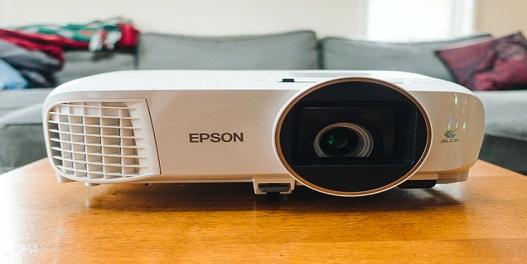
What to Look for When Buying a Projector?
If you are looking to buy a new projector for a classroom, meeting room or home theatre, the image you project on the screen should make a great impression on your audience. Researching projectors can be confusing, with many acronyms and technological terms. Our Projector buyers guide 2019 will help answer common questions regarding terminology, features and other important considerations when you are choosing a projector.
Projectors have come a long way from the days when the most useful way to categorize them was by their weight class. Today there are any number of more meaningful kinds of categories, including intended use (business presentations, home theatre, game playing), technology (LCD, DLP, LCOS), throw distance (how close to the screen you can place the projector), and more.
Buy Best brand Home Theatre, Business and Portable Projectors in Singapore at best Price.
1. Application - what do you want to use the projector for?
Firstly you should ask yourself what you want to use your projector for. There are different criteria for a range of applications a projector can be used in which should be taken into account. To simplify, we will differentiate the projectors
for the use at home and for use in business.
Projectors for use at home:
For your home cinema, we recommend a projector with a 16: 9 format resolution as most movies are available in this format. Full HD projectors (1920 x 1080 pixels) offer this resolution and have established themselves as the standard for home cinema applications. If you want to upgrade and future proof yourself, a 4K projector (3840 x 2160 pixels) is the right choice if budget allows! Some of the high-quality full HD home cinema projectors also offer 4K upscaling, such as The 4K enhancement technology. This means that the 1080p panel is able to improve the image quality to a higher resolution, bridging the gulf in cost between 1080p and 4K.
Projectors for use in business:
We differentiate between portable projectors for mobile use and installation projectors that will stay in the meeting room.
For ceiling mounting, the projector should have an appropriate mounting system and should have the automatic keystone correction feature which is very useful to compensate distortion of the projection.
Mobile devices should not weigh more than 3kg for easy transport and are usually equipped with internal speakers allowing you to hold presentations at any location. If the sound is not sufficient, you can usually connect an external loudspeaker which can be connected directly to the projector or laptop via Bluetooth or 3.5 mm jack.
Also pay attention to devices with USB or SD card slots if you want to play presentations or files without having to plug in a PC or tablet. To achieve maximum flexibility, a projector with WLAN capability is useful.
If you have an MHL-enabled smartphone or tablet, an MHL-capable projector will be interesting for you. These can be connected directly to the mobile device by cable to send content whilst also simultaneously charging the device.
Since business projectors are usually used in a bright environment, a high luminance of at least 3,000 ANSI lumens is important for displaying good contrasts. A contrast ratio of approx. 3,000: 1 is usually enough for daylight.
2. Contrast Ratio
Contrast ratio is the difference between light and dark on a screen expressed by a number. If you take the brightest white on a screen and the darkest black and compare the luminosity, you will get the contrast ratio. For example, 1000:1 contrast ratio means that the brightest white is 1000x brighter than the darkest black.
Buy Epson projector online at best price
Therefore, a high contrast ratio means the projected image will have an incredibly rich, crystal-clear detail. Contrast is especially important for the home theatre, where ambient light might otherwise prove it to be challenging to see rich cinematic content if there is not a significant enough difference between whites and blacks.
3. Resolution
Resolution is the number of dots or pixels used to display an image. Higher resolutions mean that more pixels are used to create the image resulting in a crisper, cleaner image. High resolution is important for projecting detailed charts and graphs, text, and high-definition video. The resolution is indicated by a number combination such as 1920 x 1200. This indicates that there are 1920 dots horizontally across the display by 1200 lines of dots vertically, equaling 2,304,000 total dots that make up the image seen on the screen.
Business Projector Resolutions:
- SVGA Projector (800x600 pixels, 4:3 aspect ratio)
- XGA Projector (1024x768 pixels, 4:3 aspect ratio)
- WUXGA Projector (1920x1200 pixels, 16:10 aspect ratio)
Home Theater Projector Resolutions:
- 720p (1280x720 pixels, 16:9 aspect ratio)
- 1080p (1920x1080 pixels, 16:9 aspect ratio)
4. Ease of Use
For hassle-free projection, you'll want to look for some features that enable a quick setup — so you can project right away.
These include:
- HDMI — instant and easy digital connection to high-definition devices and allows digital audio through the same cable
- Wireless capability — allows for projecting content without a cable and is available from many kinds of devices
- Vertical and horizontal image correction — allows you to quickly align a skewed image on the screen which is key to setting up in a hurry
- Instant on/off — means no extra waiting for a projector to warm up or cool down
5. Throw Distance and Positioning
The projector position and the size of the image will depend upon your room configuration. Therefore, you will need to consider the throw distance and the projector features that will give you placement flexibility.
Buy Canon projector in Singapore
A projector's throw distance is the distance between the projector and the image on the screen.
A few common throw distances are:
- Long Throw
- Short Throw
- Ultra-Short Throw
- Ram Singh
- Tags: best portable projector best projector 2019 projector buying guide 2019